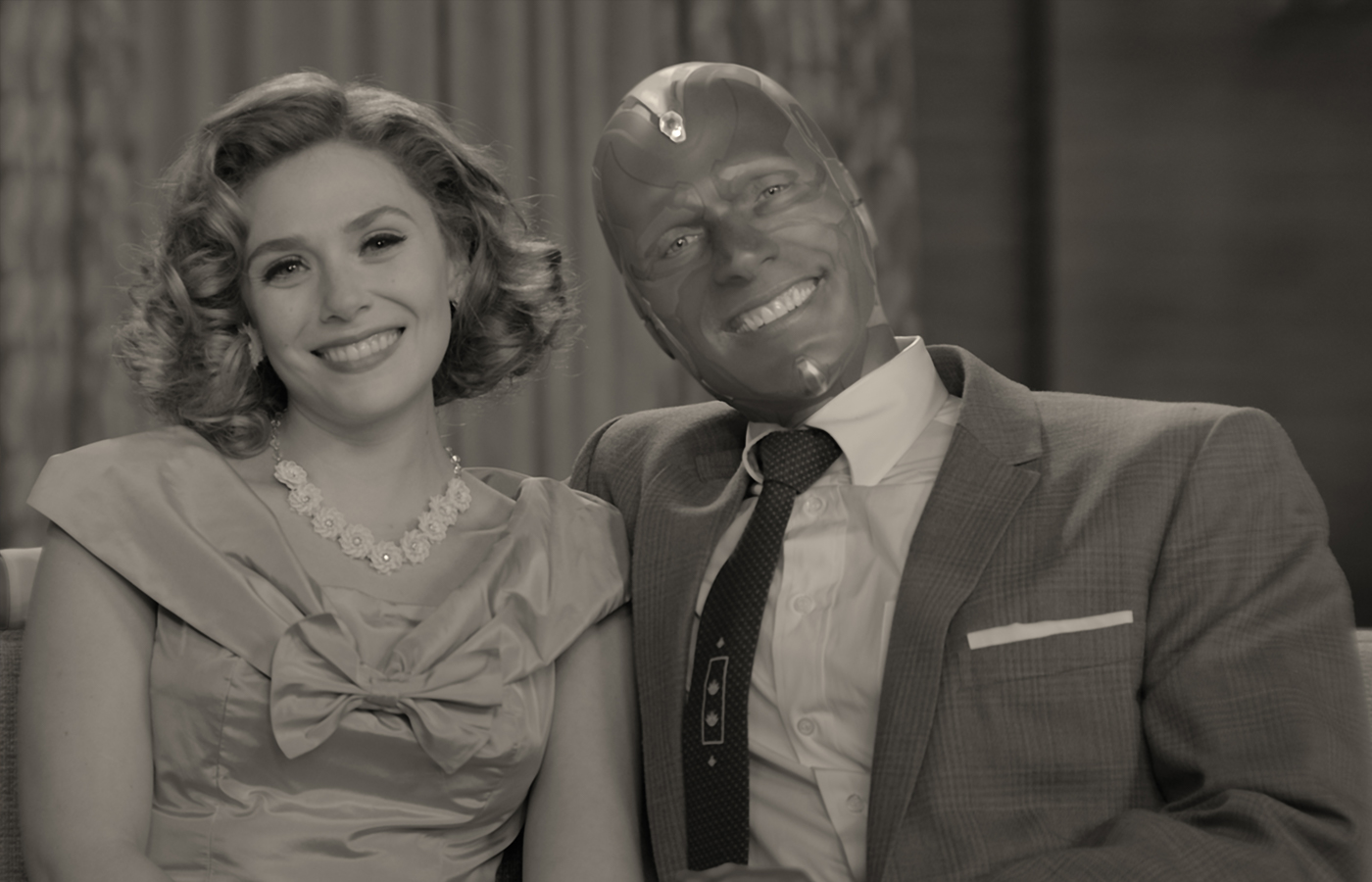Jess Hall, ASC, BSC, gets his domestic groove on for WandaVision, the most surprising new entry in the Marvel Cinematic Universe.
by Kevin H. Martin / Photos by Chuck Zlotnick and Suzanne Tenner, SMPSP / Marvel Studios
With Avengers: Endgame forming the epic conclusion to Phase 3 of the Marvel Cinematic Universe (MCU), it might be reasonable to expect less ambitious follow-ups. But if the new Disney+ streaming entry, WandaVision, is any indication, the future of the MCU promises both exciting creative departures as well as the requisite spectacle. Avengersteammates Wanda Maximoff/Scarlet Witch (Elizabeth Olsen) and the AI/Android Vision (Paul Bettany) had formed a romantic liaison before Vision’s demise in Infinity War, but when the series begins, they appear to be sharing a state of monochromatic bliss. Inspired in part by the Marvel Comics series The Vision, the pair’s daily misadventures play out in shifting realities (and over numerous decades) that reflect past TV sitcoms, which are marred only by occasional anachronisms that suggest their idealized reality is just that.
Director of Photography Jess Hall, ASC, BSC, was approached by series director Matt Shakman, who was a fan of Hall’s work on Hot Fuzz and that film’s ability to shift between comedy, action, and drama (as does WandaVision). Additionally, the changing environments would require critical attention to color detail, which Hall had demonstrated with his work on Ghost in the Shell [ICG Magazine April 2017]. Hall studied sitcoms from each period, amassing a reference library of stills from each. “I analyzed RGB values of the color palette from the various eras, sharing that data with Costume Designer Mayes Rubio and Production Designer Mark Worthington’s art department,” Hall recounts. “That gave us a lot of color integrity and let us play complementary colors in clothing and on the walls against one another, which I could augment with lighting gels.”
Many of WandaVision’s visual components evolve as episodes progress from early black-and-white-era TV stylings toward modern episodics and eventually a return to MCU standards. “The camerawork, lensing, and composition change as the series progresses, along with the aspect ratio,” Hall adds. “We start with Academy 1:33, then go to 1:78 before winding up at 2:39. Some episodes intermingle period hence the aspect ratio changes or even transitions within single shots.”
While other recent productions, such as Mank, shot by Erik Messerschmidt, ASC, used a sensor that captured in black and white, Hall took a different approach. “Since we’d be moving from black-and-white to color, I didn’t choose a monochrome chip because I wanted a single camera platform throughout. That’s how I shot for the Smirnoff Infamous Since 1864 commercial (AICP Award winner for Cinematography and Color Grading) which also takes the viewer through various historical periods. I wanted a camera that provided enough image information to allow me a diverse palette in a range of formats, including using 1.3× anamorphics on later episodes. The big sensor of the ALEXA LF, augmented by the LF Mini, provided a flexible platform and a color space I was confident I could push in several directions.”
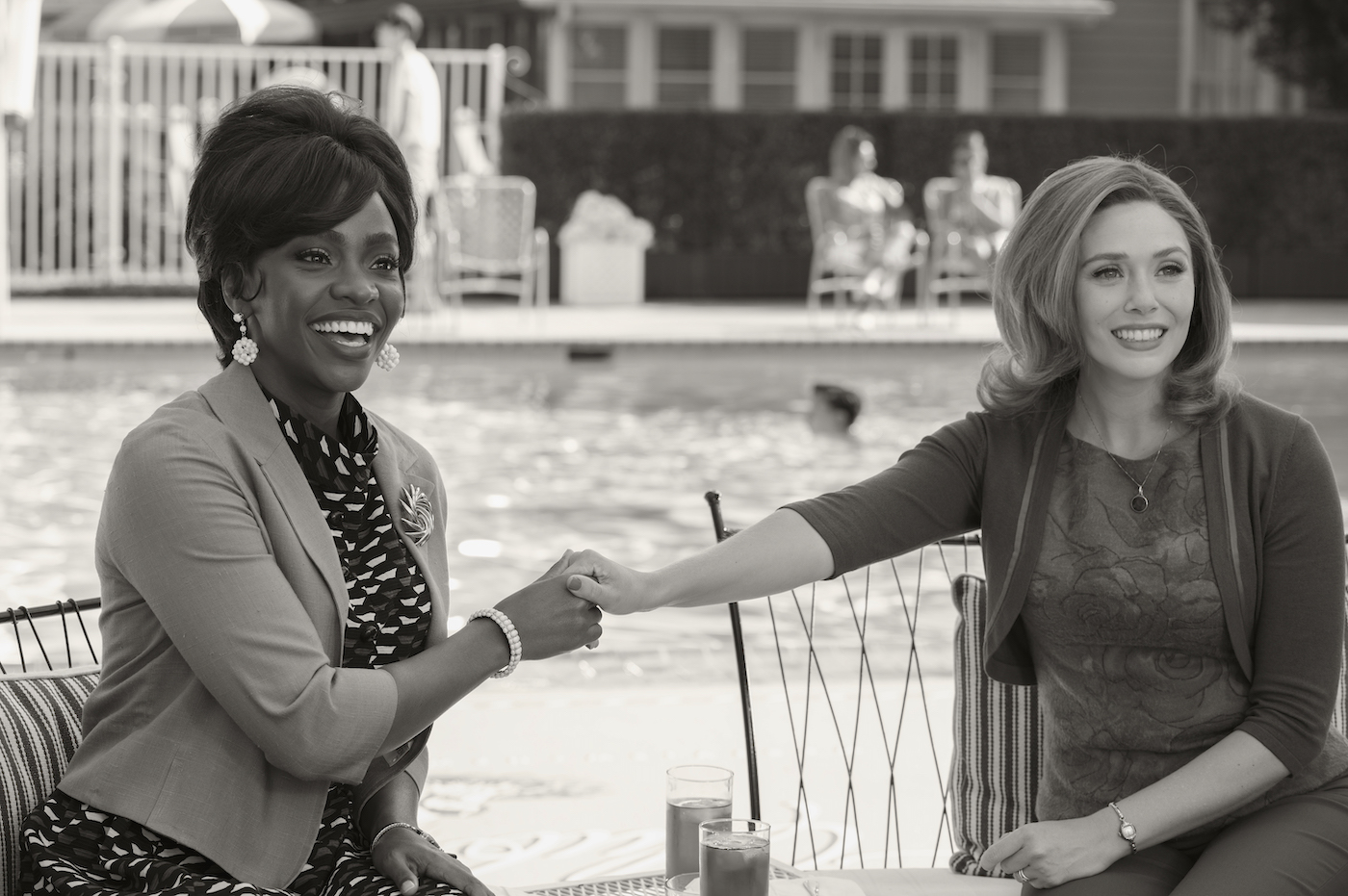
The monochrome look was built into a LUT designed in collaboration with Technicolor’s Josh Pines and Chris Kutcka. Hall says they largely used the values of color elements in-shot to dictate the tonal palette of the black-and-white. “Black-and-white film stocks traditionally do not have equal sensitivity across the color spectrum,” he notes, “so we played with that principle. For example, the walls on The Dick Van Dyke Show [1961–1966] had been painted blue-green, which contrasted nicely with warm skin tones. This enabled us to choose particular colors and enhance their luminance or shift their tonal value individually, without using a key – by applying a color matrix to the RGB image, we could more closely emulate the response of a traditional black and white film stock. Doing this outside of the LUT ultimately gave us more control and flexibility.”
Hall also embarked on a detailed series of lens tests to lock in his variegated approach, with Marvel embracing the testing and the various looks. “Their brief to me was, ‘Bring feature quality to streaming,’” adds Hall, who had never previously shot television. “At six hours in length, this was like shooting approximately three movies. I had the support to go into feature-level prep, especially as we were establishing a new workflow for the streaming platform. Naturally, that time was compacted, particularly towards the end of our prep schedule.”
The lens tests included older glass, with Panavision’s Dan Sasaki rebuilding P-Vintage lenses into new assemblies for the early episodes, augmented by modified Cooke Series 2 zooms. “I attempt to control the look and put my mark on the image by getting as much of the look in-camera [as I can], as opposed to relying too heavily on post,” Hall continues. “We knew it would take work in-camera to get the look for the ’50s/’60s and ’70s eras, in particular. In testing, my preference was for the older lenses, combined with Black Vintage Christian Dior net behind the rear element. However, due to the scarcity of the original glass, it would have been hard to put two matching sets together. The lenses were also fragile, so adapting them was complex and would only allow us to push the characteristics so far.”
The option for Hall was to explore what Sasaki described as “adaptive optics.” According to Sasaki, exploiting this concept beyond what Panavision has done on any previous project. “Adaptive optics involves a new optical assembly that incorporates additional elements to the existing glass. Hall says this approach “enabled us to get close to our desired look, which was formed in part by period authenticity and partly reflected my own aesthetic preferences in terms of what the narrative required.”
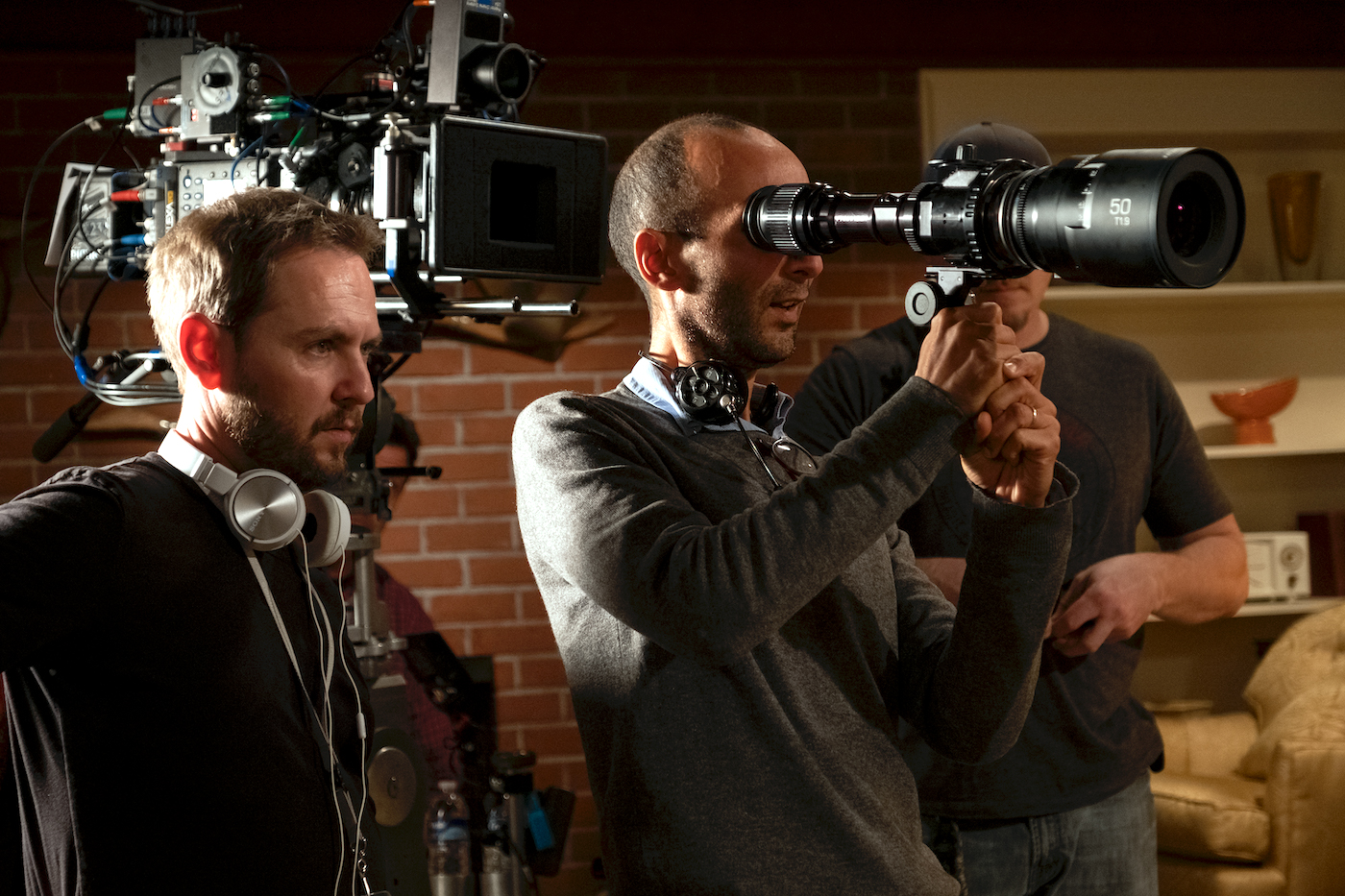
Hall says the adaptive optics let him push lensing anomalies and character further than simply detuning or using existing vintage glass. “It wasn’t a uniform application,” he explains. “We were able to alter the image in terms of fall-off in focus, highlight halation and lens curvature, in addition to softening the image in selective color. We built two full sets for Episodes 1 through 3 and scaled them so that the characteristics varied in relation to the iris. I could shoot these lenses for the ’70s-era shows at a T4-5.6 for a moderate look, then shoot the same glass at T2.5-2.8 for the ’50s look and achieve a more dramatic effect.”
The team built a unique 50mm and 75mm portrait lens for Wanda’s close-ups, which emulated a look Hall had seen in prep when he projected 35-millimeter prints of Bewitched [1964–1972], sourced from the show’s original negative. “They used a more classic, cinematic beautification of Elizabeth Montgomery on these shots than I’d associate with TV of the period,” Hall adds. “In fact, these close-ups fetishize her beauty in a way that struck me as both unusual and impactful.” Hall says they enhanced the center-weighted aspect of the portrait lenses, providing an increase in the fall-off in focus, as well as increased softness and halation. “I think these special lenses helped express Wanda’s character predicament, highlighting the grief and isolation at key dramatic moments,” he describes.
Episodes taking place in more recent TV eras were shot with Panaspeed primes and Fujinon zooms, while full-on MCU aspects relied on Ultra Panatars, which was the same series of lenses used in Avengers: Endgame. In all, Hall wielded 47 different lenses.
“Since we were among the first Marvel shows on Disney+, I was deeply involved with Marvel’s post team, led by Evan Jacobs and Mike Maloney,” Hall continues. “We collaborated on their initial workflow and HDR testing that would, to a greater extent, extend into the rest of MCU, Phase 4 streaming work. They had not mastered in HDR on set for the previous features, instead doing a conversion. This time, though, I worked with 4K HDR monitors on set; DIT Kyle Spicer had to completely redesign the HDR cart to work in 4K live.”
Two 32-inch Sony HX-310s and a pair of PVM A250s for SDR viewing made up Spicer’s viewing station. “Those monitors were beasts, just incredibly heavy,” states 1st AC Sean Moe. “Kyle had to have help to lift them off his cart each night. But the image was amazing; he caught detail I couldn’t even see on my 1080p monitor.”
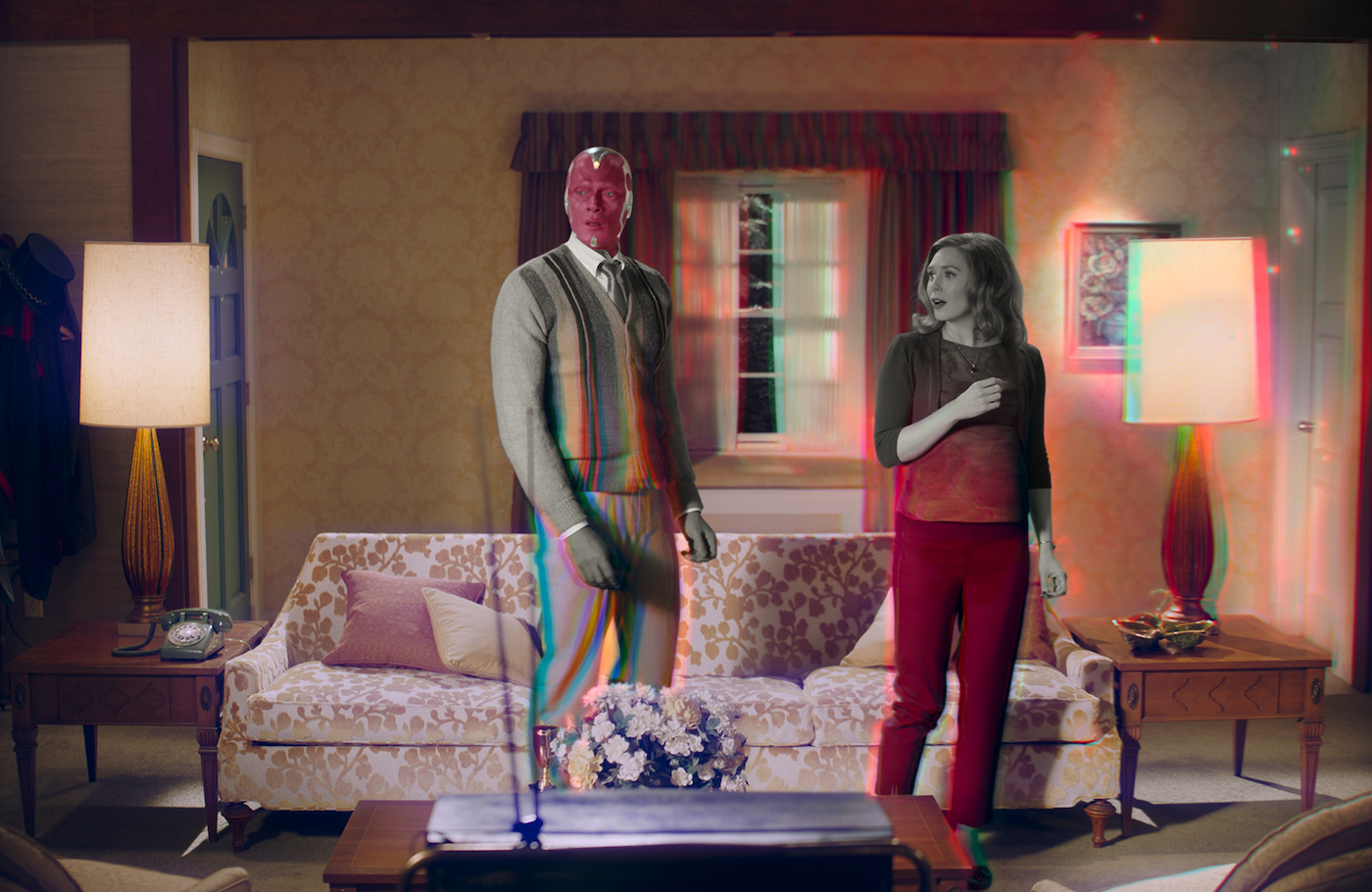
DIT Spicer is another MCU vet and says the DI-grade monitors on set provided the truest color. “We were in HDR from Step 1 to DI, all the way through as our master,” he shares. “Typically, HDR and SDR passes are done at the end of a feature, after everybody views SDR on set and in editorial. Then a trim pass is done on the HDR side, where the SDR is tweaked. Marvel and Disney knew this was going to be streaming, not in theaters, and also that future-proofing was a concern, so HDR became the primary issue rather than treated as a sidebar to the SDR finishing. In the DI, it was mastered in HDR, and the trim pass was on the SDR side. We’re doing the same thing on Hawkeye now.”
The streaming series, Spicer observes, felt more like a feature. “Everybody was trying to squeeze the best possible production value out of the work,” he declares. “It’s very close to a feature-style workflow, but with key differences. We had three LUT’s for each period, plus varying LUT’s depending on the camera used, so 23 in all. While we were matching to very specific styles of sitcoms past, Jess brought his own twist to reflect the dramatic issues with the characters.”
To combat the common complaint of HDR being too bright, nit-levels for MCU scenes were limited to 600. “Kyle did a brilliant job of archiving,” Hall lauds. “He had a huge volume of high-quality reference material at hand at any given moment, so the DIT tent was a command center from which all this info could be retrieved. Kyle already knew how Marvel liked to organize the material and data. It seemed incongruous at first that we were using all these high-resolution processes to produce a degraded 1950s image. But that was only part of the look for the series. In the early episodes, we limited the highlight range to 100 nits, to more accurately reflect the technology of the period. Coupled with a soft roll-off, it got us the desired look in the highlights.”
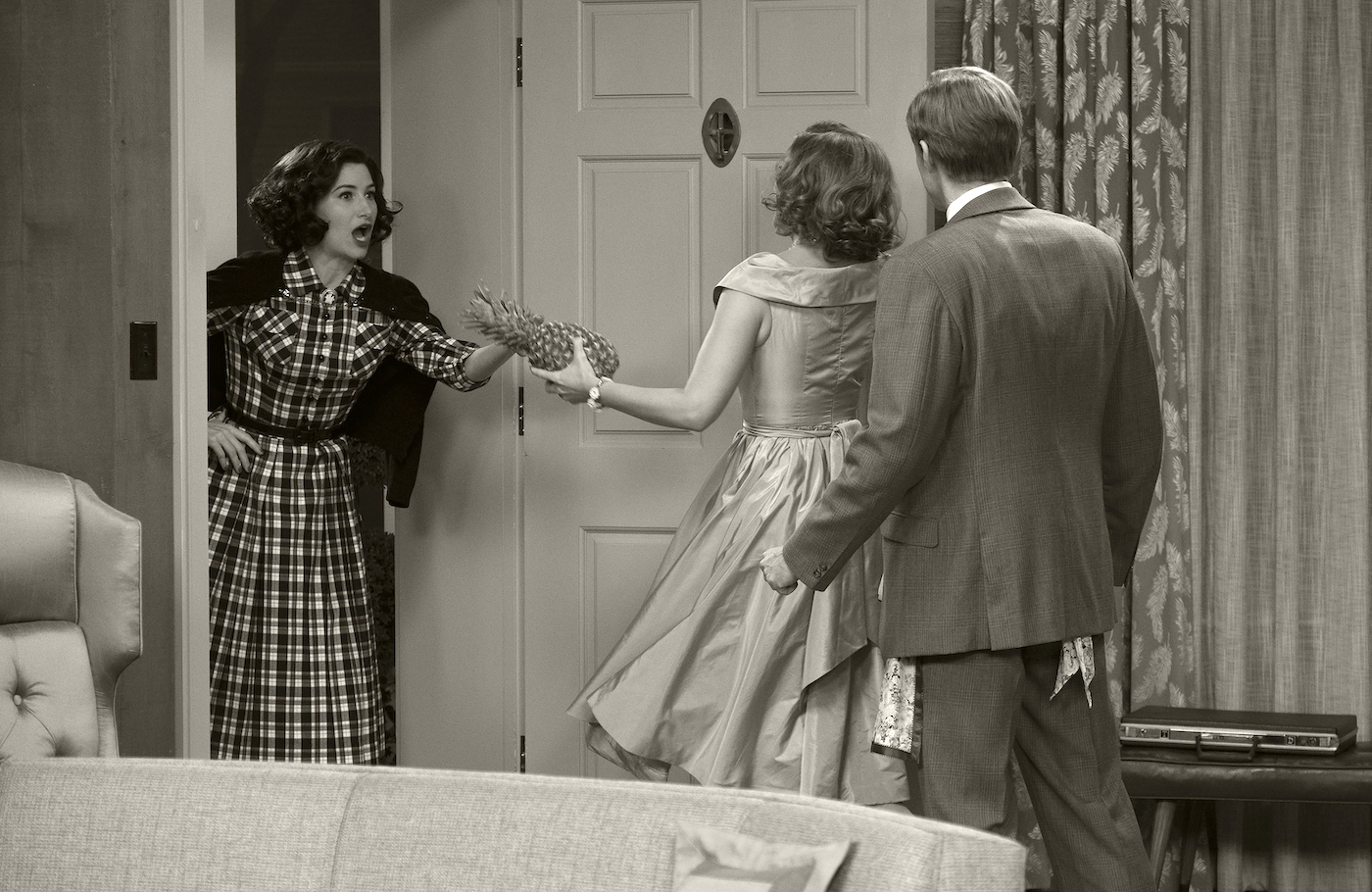
To convey greater period verisimilitude, WandaVision’s first episode was shot live with a studio audience. Hall used three cameras, and then shot pickups as inserts later. “Overall, it was treated very much as it had been in the past, stopping only for set changes,” he explains. “The lighting was broad, and the camera was limited to moves associated with live shows. I did live cues on the lighting while speaking to the operators by headset.”
The live audience shoots called for the crew to get into the act. Moe says, “We all dressed up with hats and ties [Midcentury] style. The audience was assembled with NDA’s to keep the secrecy aspect.” Movement of the camera by A-Camera Operator Henry Tirl was deliberately limited, in keeping with the style of the era. “We didn’t do a lot of panning and dollying,” Moe states. “If we had a two-shot, I wouldn’t ever rack focus, because that wasn’t done on The Dick Van Dyke Show. Those kinds of moves [in sitcoms] came decades later when shooting the Modern Family-era stuff, plus the MCU material.”
Hall also employed period lighting. “My gaffer, John Vecchio, went to various studios, including Paramount, to source a variety of old units,” he reveals. “To keep the sets cool, and because we were working at 800 ASA, not the 50 or 100 ASA these lights were designed for, I used 2Ks or 5K bulbs within the old Big Eye 10K Fresnel housings, which still gave me the same quality of light.
“And I limited Key Grip Jim Kwiatkowski to period diffusion materials like Tough Soft Frost and Spun diffusion,” Hall continues. “He was able to source several rolls of discontinued materials like Rosco Spun Silver. Episode 2 moves towards single camera, reflecting the later era. That work used a more traditional hard-key light and 3-point lighting structure. I utilized more light control in the form of flags and snoots, and an old-style light on [Elizabeth Olsen]. The general contrast is increased with deeper blacks and we move to a cooler D62 white point, from the D58 of Episode 1. Lighting was strictly tungsten in the early episodes, except for a small amount of LED in the ‘70s that I required for specific color temperature reasons.”
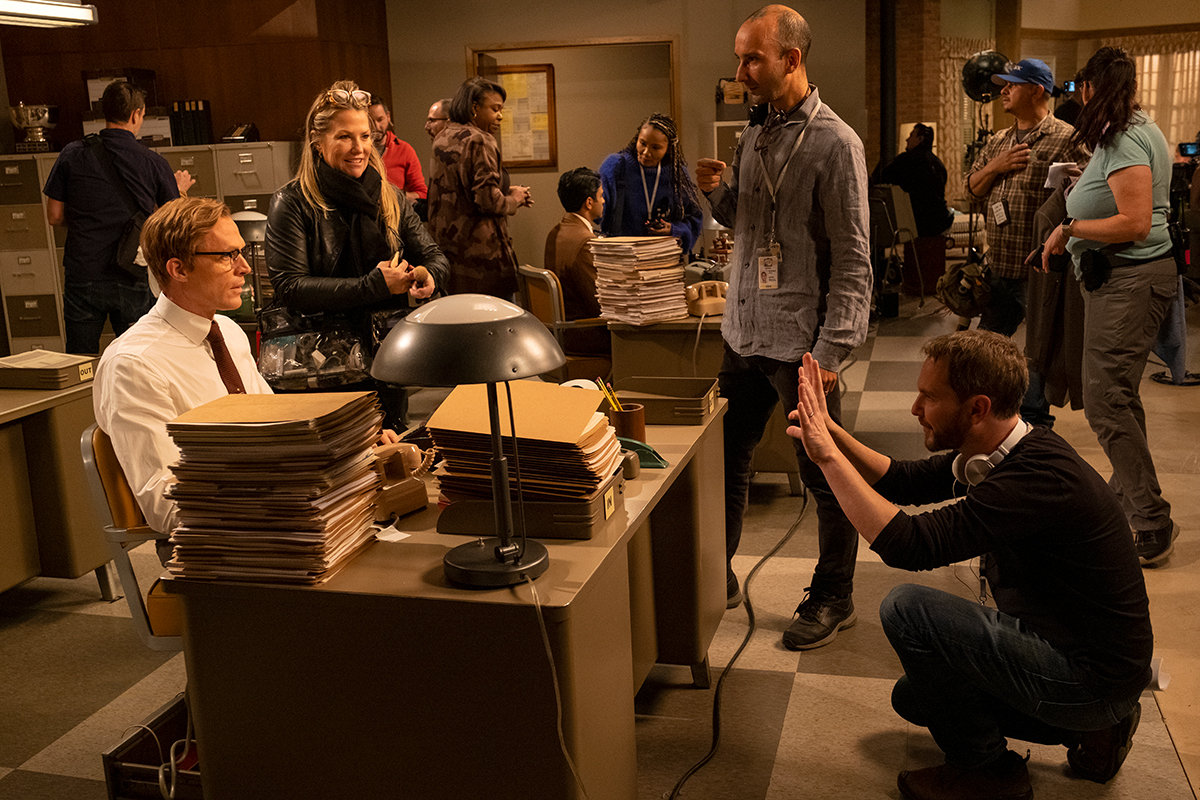
With the switch to modern sources in later episodes, Hall was able to reference the saturated look of Marvel Comics – in a controlled manner. “Although I didn’t lean stylistically towards the compositional style of the Marvel comics for our MCU material, I was influenced by their richness of color, particularly in House of M and Scarlet Witch Vol. 3: The Final Hex,” he acknowledges. “I glimpsed an opportunity to exploit the expanded color gamut possibilities of the HDR platform to render some of the richness and vivid color that was used so effectively as a design element in the original intellectual property. [I utilized] a customized LED color palette [to map] various LED fixtures, which permitted me to maintain precise color control and consistency. This was done by generating XY values from colors, using RGB values from the Digital Sputnik as the master.”
Spicer notes that “the lighting manufacturers all show you a different color value when you ask for sky-blue. So, for Jess to be able to get all of those – plus some consumer-level LED’s in the set – to live together and match was a big win. Even consumer LED’s that go into the set.” Hall’s team employed a spectrometer to create RGB values for additional fixtures – ARRI SkyPanels, Kino Flo Freestyles, Astera Titan Tubes, and AX3s– matching the source XY within .001 to .003 of the original XY value. Other interactive lighting elements placed near or on the actors were made from LiteGear RGBW ribbon, for which Hall established color values by eye, via the camera, using his MCU LUT.
“We moved the camera differently in the modern-era scenes, making extensive use of the Technocrane, dolly, slider, and drones,” Hall states. “We tried to maintain some simplicity and elegance in the camera choreography of our action sequences as that would blend more succinctly with the period work, and we didn’t want the transitions to be too abrupt. Matt has a background in theater and favors strategies that enable his actors freedom of performance. So, we often established longer moving master shots that could accommodate the blocking.”
After the bulk of shooting was completed at Pinewood Studios, Atlanta, and other parts of Georgia, production was slated to resume in California at the Warner Bros Ranch in Burbank, including on the historic Blondie Street. But, as Hall notes, “we were on a month’s hiatus when COVID happened. One positive aspect emerging from the shutdown was having time to set up a remote DI at my home, which Marvel helped with,” he says. “I have a room with a calibrated monitor Resolve fed in real-time from the grading suite. Resolve can change contrast curves or window or blending VFX plates with live-action. Thus, when we started up again six months later, I had completed considerable color grading work, and accumulated a lot of knowledge by looking at what we had shot previously.”
Storyboards and previs were used on more complex sequences. “I got in a room with Matt and contributed there,” Hall adds, “ensuring our lenses got mapped so the previs would accurately reflect our lensing and the way we intended to shoot each era. That allowed us to determine the size of green screen we required or design the stunt rigging. And with the volume of VFX work being spread across so many vendors, it became more challenging to control issues with color space. We fed the VFX vendors base grades from the DI when possible, as well as our LUT’s. A CDL developed on set works in that moment, but the look did shift in the DI when examining a whole episode in context. Marvel built their own digital intermediate facility, which worked in Resolve. I had Technicolor colorist Matt Watson doing my dailies and my finals.”
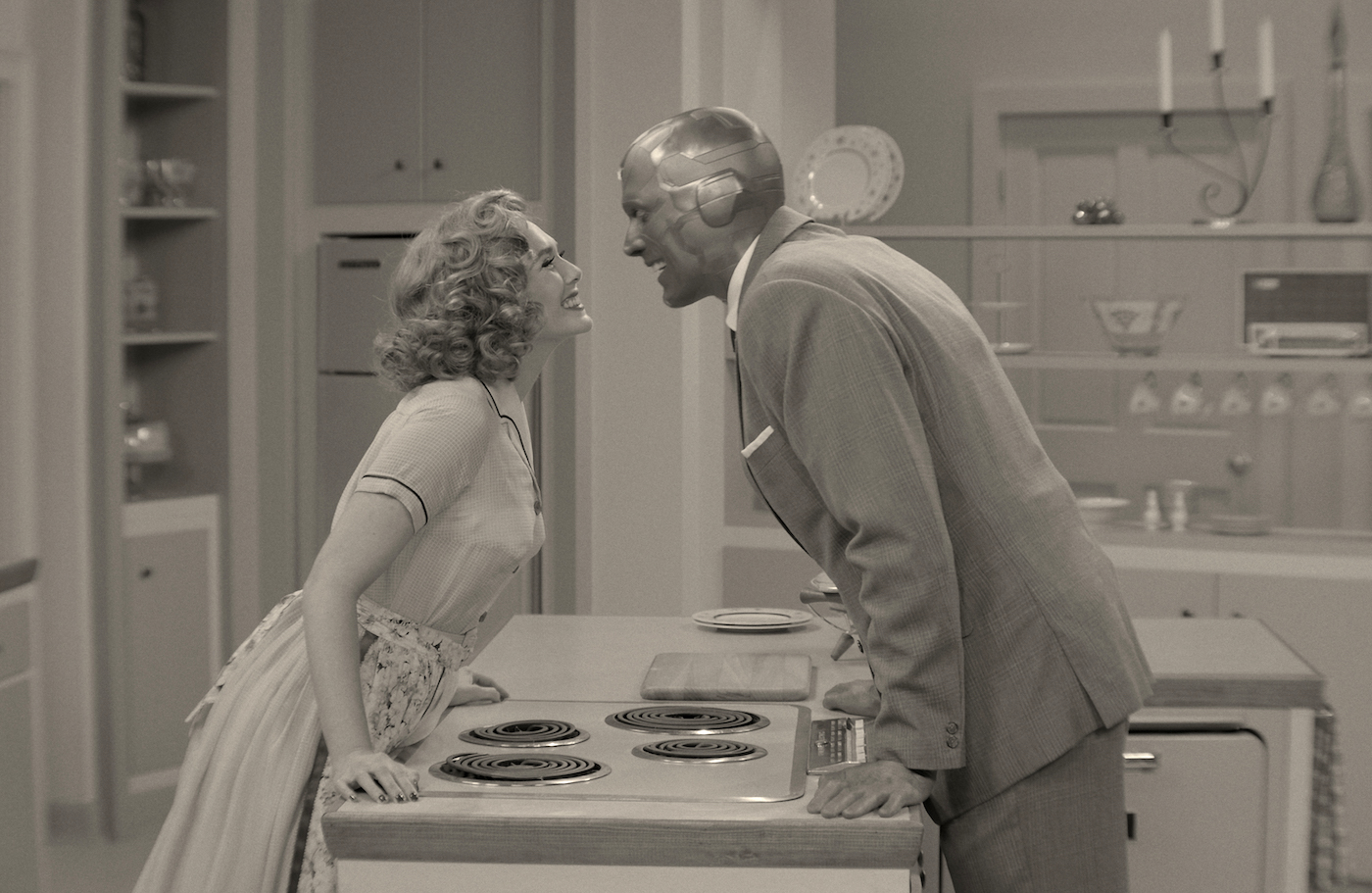
While the early episodes deliberately employ old-school, in-camera effects, ranging from jump-cuts and undercranking to wire gags – digital trickery, under the stewardship of VFX Supervisor Tara DeMarco, is still a significant presence.
“I came on early enough to sit with the department heads and help determine which effects technique would work best in each period,” DeMarco reports. “We always knew that puppeteered wire rigs were going to figure into the early episodes, so those conversations involved special effects and props, as well as camera placement and lighting for Jess. Dan Sudick has a long history with Marvel features, including Infinity War and Endgame, and is head of special effects for all Marvel streaming shows. His background included a fair amount of wirework, so we relied on him to determine what could and couldn’t be done practically.
“The post-work we did on the early shows is intended to look like it was done in those less-advanced times,” DeMarco continues, “except for Vision and his CG face. We set up a color pipeline for the VFX vendors – who had already done Vision in the features – because black-and-white Vision actually has blue skin in order to read as a silvery tone. So, there was extensive testing for makeup color, AI color, and figuring out where we wanted our white balance to fit to arrive at a final grade that felt rich and looked period after we had added grain. The VFX vendors would deliver EXR’s back in color, so we could balance the black-and-white ourselves, plus a QuickTime reference that used the LUT and CDL so they could see where we were going. Many times, we gave pre-graded reference from the DI, especially with the ’70s sequences, for which we wanted a look that was even bolder than that of the dailies.”
The volume of VFX expanded with each episode, which DeMarco says was a conscious part of the transition from early TV to the MCU of recent features. The VFX shot number continued to grow in post to more than 3000 cuts. “The post workflow Evan Jacobs built out is incredible, and it means we can do a lot of things without ever going outside of Marvel,” DeMarco adds. “The company also has an incredible archive, so if you are interested in reviewing the look of a past effect and to see how it was done, they have a great resource on all those previous projects that you can examine.”
Looking back on his involvement, Hall says Marvel’s success starts from the top. “Even though [Marvel Studios President] Kevin Feige presides over the most successful film franchise of all time, he did not play it safe, producing something in WandaVision that might be considered avant-garde, or at the very least, highly conceptual, relative to past Marvel work. That is indicative of a highly creative person.,” Hall offers. “WandaVision was an exciting departure and one I’m delighted to be a part of. When I started doing research, I was captivated by the imagination and creativity I saw in older episodes of The Twilight Zone. With the current volume of content available, viewers could easily become oversaturated, so looking at different and inventive ways to present a story seems an intelligent option.”
Hall points to the many subtle tonal shifts throughout WandaVision. “The range is immense – from comedy and romance to sci-fi action and drama, and this made it especially appealing,” he concludes. “There are so many characters in a Marvel Avengers feature, you can only manage snippets of time for each. I loved that this series gave us the opportunity to explore the love story between Paul and Lizzie’s characters, expanding on those brief, beautiful moments they had in Age of Ultron and Infinity War, and delving more deeply into that relationship. That is a gift for any cinematographer.”
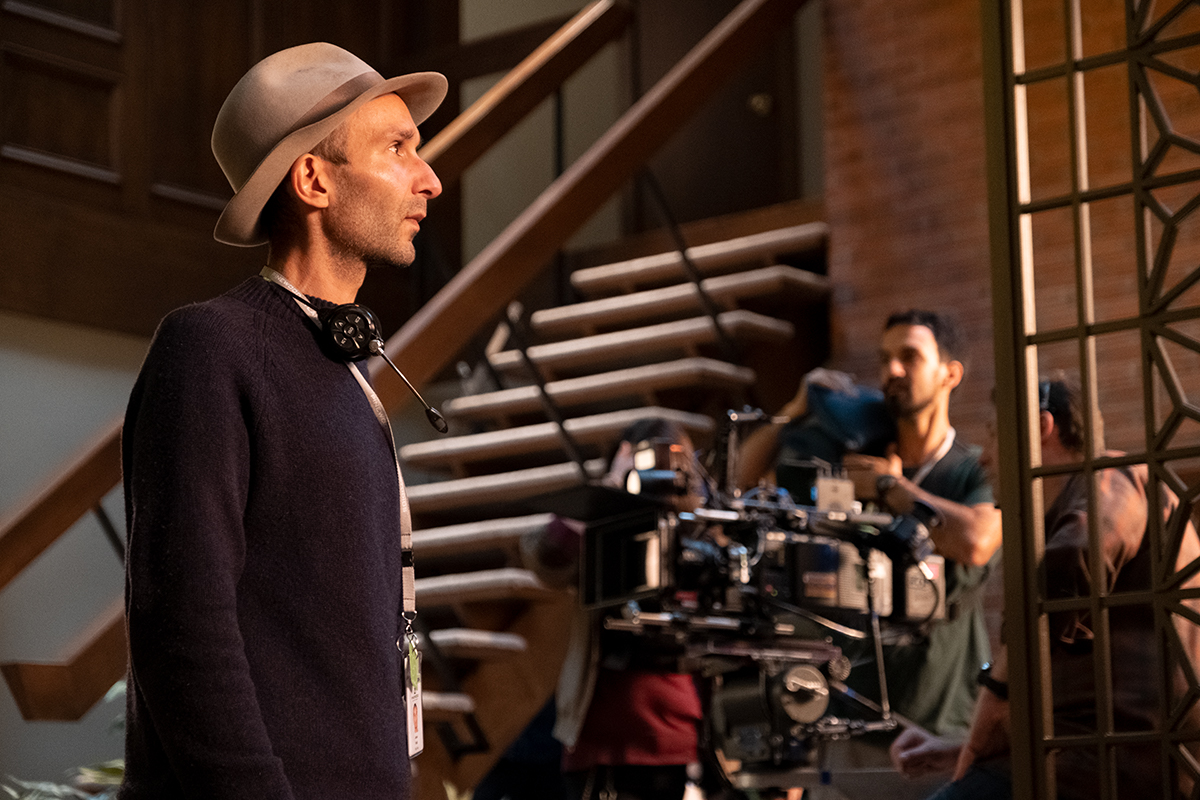
Local 600 Camera Team – WandaVision
Atlanta
Director of Photography: Jess Hall, ASC, BSC
A-Camera Operator/Steadicam: Henry Tirl
A-Camera Operator: Dave Luckenbach, SOC
A-Camera 1st AC: Sean Moe
A-Camera 2nd AC: Zach Junquera
B-Camera Operator: Jeff Crumbley, SOC
B-Camera 1st AC: Trey Twitty
B-Camera 2nd AC: Bess Johnson
C-Camera Operators: Ian Clampett, Hugh Braselton
C-Camera 1st ACs: Alessandro Di Meo, Dwight Campbell
C-Camera 2nd AC: Victoria Warren
Loader: Kat Soulagnet
Utility: Torey Lenart
DIT: Kyle Spicer
Still Photographer: Chuck Zlotnick
Publicist: John Pisani
Los Angeles
Director of Photography: Jess Hall, ASC
A-Camera Operator/Steadicam: Henry Tirl
A-Camera 1st AC: Sean Moe
A-Camera 2nd AC: Paul Tilden
B-Camera Operator: Dave Luckenbach, SOC
B-Camera 1st AC: Craig Grossmueller
B-Camera 2nd AC: Miki Janicin
C-Camera Operators: Chris Duskin, Lukas Bielan
C-Camera 1st ACs: Dan Ming, Dennis Geraghty
C-Camera 2nd AC: Kalli Kouf
Loader: Kat Soulagnet
Utility: Torey Lenart
DIT: Kyle Spicer
Matrix Head: Jason Sutton
Still Photographer: Suzanne Tenner, SMPSP
Publicist: John Pisani
